
Subaru Corporation, formerly Fuji Heavy Industries, Ltd., is a Japanese multinational corporation and conglomerate primarily involved in both terrestrial and aerospace transportation manufacturing. It is best known for its line of Subaru automobiles. Founded in 1953, the company was named Fuji Heavy Industries until 2017. The company's aerospace division is a defense contractor to the Japanese government, manufacturing Boeing and Lockheed Martin helicopters and airplanes under license. This same division is a global development and manufacturing partner to both companies.
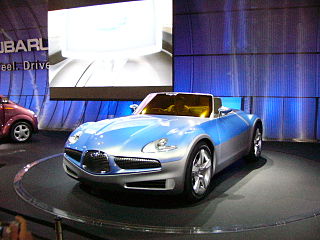
The Subaru B9 Scrambler is an open two-seat concept sports car from Subaru featuring classic styling. It is 4.2 metres (165.4 in) long and powered by a 140 hp (104 kW) gasoline-electric hybrid engine. It was designed by Andreas Zapatinas.

The Geneva International Motor Show was an annual auto show held in March in the Swiss city of Geneva.

The Subaru 1000 is a car produced by the Japanese company Fuji Heavy Industries from 1966 to 1969. It was the first-and-only Subaru with front-wheel drive that was in the Japanese government "compact car" classification. Previous Subaru models such as the Subaru 360 and the Sambar had been rear-engined, rear-wheel drive kei cars.
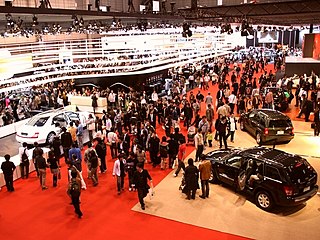
The Japan Mobility Show (ジャパンモビリティショー), called Tokyo Motor Show (東京モーターショー) (TMS) until 2019, is a biennial auto show held in October–November at the Tokyo Big Sight, Tokyo, Japan for cars, motorcycles and commercial vehicles. Hosted by the Japan Automobile Manufacturers Association (JAMA), it is a recognized international show by the Organisation Internationale des Constructeurs d'Automobiles, and normally sees more concept cars than actual production car introductions, which is the reason why the automotive press sees the show as one of the motorshow's big five.
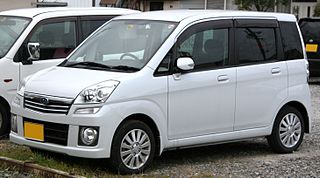
The Subaru Stella is a 5-door kei car produced by Subaru starting in June 2006. The Stella is based on the same architecture as the Subaru R2. It can be considered as a direct replacement of the Subaru Pleo, although the Pleo soldiered on for another four years. It was Subaru's re-entry into the market segment dominated by the Suzuki Wagon R and the Daihatsu Move, hoping to recapture market share after the R2's lower-than-expected sales. The Stella's dimensions are more parking structure-friendly where vehicle stacking is utilized over the Pleo. The most recent generation Stella is a rebadged Daihatsu Move.
Subaru Transcare is a range of modifications available for Subaru vehicles to enable their use by elderly or disabled persons. The company featured this range at the 38th Tokyo Motor Show, 2004, under the slogan "Open all roads: Vehicles for broadening opportunities and enriching life".
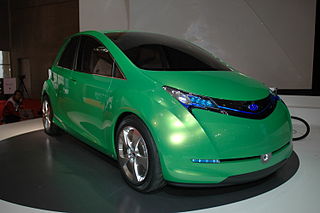
The Subaru G4e is a concept electric car developed by Japanese automaker Subaru in conjunction with Tokyo utility TEPCO as a possible successor to the R1e. It was unveiled at the 2007 Tokyo Motor Show.

Subaru is the automobile manufacturing division of Japanese transportation conglomerate Subaru Corporation, the twenty-first largest automaker by production worldwide in 2017.
Toyota Concept Vehicles produced between 2010 and 2019 include:

The Subaru Tribeca was a mid-size crossover SUV made from 2005 to 2014. Released in some markets, including Canada, as the Subaru B9 Tribeca, the car derives its name from the Tribeca neighborhood of New York City. Built on the Subaru Legacy platform and sold in five- and seven-seat configurations, the Tribeca was intended to be sold alongside a slightly revised version known as the Saab 9-6X. Saab, at the time a subsidiary of General Motors (GM), abandoned the 9-6X program just prior to its release subsequent to GM's 2005 divestiture of its 20 percent stake in FHI.
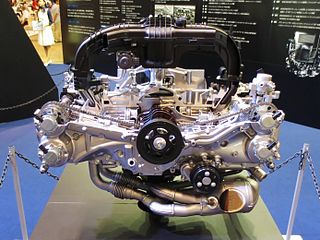
The Subaru FB engine is the third and current generation of gasoline boxer-4 engine used in Subaru automobiles, and was announced on 23 September 2010. It follows the previous generation EJ-series engine which was introduced in 1989 and the first generation EA-series which was introduced in 1966. By increasing piston stroke and decreasing piston bore, Subaru aimed to reduce emissions and improve fuel economy, while increasing and broadening torque output compared to the EJ-series.

The Subaru VIZIV is a series of hybrid concept sports SUVs designed and built by Subaru, the first of which was unveiled at the 2013 Geneva Motor Show. The VIZIV series included several signature Subaru design features, such as the use of horizontally-opposed engines and all-wheel drive, and built on prior Subaru hybrid concepts such as the B9SC, B5-TPH, and Hybrid Tourer by using a three-motor layout. Since 2016, the VIZIV concept cars have previewed styling for upcoming production automobiles, and the hybrid powertrain has been dropped in favor of a conventional gasoline engine and all-wheel-drive.

The Subaru B11S was a concept sports coupe made by Subaru, introduced at the 2003 Geneva Motor Show.

The Subaru B5-TPH was a concept shooting-brake coupe with a Turbo Parallel Hybrid (TPH) powertrain made by Fuji Heavy Industries (FHI), introduced at the 2005 Tokyo Motor Show.

The Subaru Hybrid Tourer is a hybrid concept sport utility/grand touring vehicle designed and built by Subaru, unveiled at the 2009 Tokyo Motor Show. The Hybrid Tourer included several signature Subaru design features, such as the use of a horizontally-opposed engine and all-wheel drive, and built on prior Subaru hybrid concepts such as the B9SC and B5-TPH by using a two-motor layout. The Hybrid Tourer was succeeded by the 2011 Advanced Tourer concept and the 2013-15 VIZIV diesel hybrid concept series.

The Subaru Crosstrek is a compact crossover SUV produced by Subaru since 2012. It is a successor to the Outback Sport in the United States and Canada, and the Impreza XV globally. Like the Outback Sport, the Crosstrek is a lifted Impreza hatchback with minor differences, though with a more substantial lift than the Outback Sport.

The Subaru Global Platform (スバルグローバルプラットフォーム), abbreviated as SGP, is the modular unibody automobile platform for nearly all models manufactured by Subaru, starting with the fifth-generation Subaru Impreza in 2016. The primary dynamic benefits of SGP compared to prior Subaru platforms were improved strength, increased rigidity, and a lowered center of gravity. In addition, moving to a common platform made production more flexible and efficient; existing production lines could shift to meet demand by producing different models without significant reconfiguration, and common parts could be reused between models.

The Subaru STI E-RA is a racing vehicle equipped with a battery-electric drivetrain. It was developed by Subaru's performance and racing division Subaru Tecnica International (STI). The car's initials stand for "Electric—Record Attempt", keeping with STI's tradition of designating its highest-performance models with the "RA" label; a concept car prototype debuted at the Tokyo Auto Salon in January 2022.

















